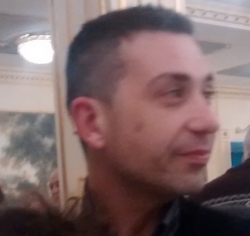Andrea
About
- Username
- Andrea
- Joined
- Visits
- 2,622
- Last Active
- Roles
- Member
Comments
-
If can help you this version of CCX runs: http://www.calculixforwin.com/ Regards
-
LIML file Regards
-
OK! Some time ago I found another issue on all CCX versions compiled for Win. Also the latest. This issues is relative to a combination of Rigid Body and Equation cards. In this case the solver, under Win, crash. Under Linux is all OK! The problem o…
-
Look at this. Try to check also high eigenvalues https://youtu.be/EjBBlOg1QKE
-
Inside Mecway....using ccx.exe is all right. Using ccx_MT.exe I had issues. If your test will be positive depends from the solver instead could depend from the OS (I use W7) I attach liml file. I will try the ccx.exe from kwip.....same problem Run…
-
I found that CCX_MT.exe could give inconsistent results for buckling analysis. Solving the same model several times the results are different. For simple model is possible to understand that the solution is wrong but for complex model is better to a…
-
You could build your own comparative studies following NAFEMS benchmarks. Abaqus documentation contains a large number of Benchmarks and you could reproduce them in Mecway. Some years ago I made some Benchmarks for CCX solver for linear elastic pro…
-
I think that could be usefull to choose the lenght unit at the unv mesh import, like an option, the same thing for inp import. In Salome I don't take care about unit system. For me 1 unit lenght = 1 mm. For example an improvement could be: "Orig…
-
For now I solved scaling mesh under Salome
-
Yes. This was the problem which depends from CAD model. Now I have to apply different thickness to some faces but, if I remember what wrote Victor, it is possible creating a New Component. These faces must be a part of a group of elements. Regards…
-
Hi Sergio! The problem is not to obtain all quads. The problem is the mesh which is disconnected between one face to another at the common edge/s. Surely depends from step model because operating a boolean operation in Salome (fuse) the resultant me…
-
Here the final mesh...good results in 2 minutes
-
The aim using DCOUP is to obtain a 2D hinge. Using RB instead DCOUP the result shows bending (see attached picture...the model was created with hurry). I choose this asymmetric model for this. My interest is to simulate pantograph structures but is …
-
Hi! I attach the liml file relative to the study with C3D20 elements. You can change elements type in Mecway if you want. Regards, Andrea
-
But the right sintax is: *CONTACT FILE CDIS, CSTR Try to write this
-
* identifies an INPUT DECK If you omit * CCX doesn't recognize the command
-
Don't you see this?
-
Do you mean the pressure contact? *CONTACT OUTPUT CDIS,CSTR requests the storage of the relative contact displacements and contact stresses in the .frd file
-
Maybe you're right. EN 13455 (European standard for pressure vessels) contains a route based on material nonlinearity and this was introduced about 10 years ago but requires good knowledge in FEA (above all to perform Progressive Plastic deformation…
-
Ok! It's a classical one (ASME code). Reading about SCL i found that it can understimate or ovestimate stresses if the stress distribution isn't axisymmetric. The most recent proposal is to consider, for general cases, Stress Classification Plane in…
-
Which theory did you follow for calculating SCL Victor?
-
It's an interesting project! I read how to prepare the input files. It's applicable to Calculix. From frd file is possible to extrapolate the stress tensor. The problem is that you need a unitless preprocessor or N/mm because the stress accepted in…
-
As I wrote I never used 1D elements on CCX but reading the manual: The displacements are best obtained in the non-expanded view, i.e. using the OUTPUT=2D option. This means that for the present results the example had to be run twice: once with the…
-
Because is a square section. Reading CCX Manual is possible to understand that: The actual cross section is taken into account by appropriate placement of the integration points. So the calculus is based on the correction of the position of the i…
-
P:S: Does is possible to move in other place the button "SOLVER"?
-
I check the stp file. Nothing is wrong. I think. But is not important. I prefer a inp file more simple as possible.
-
Here the LIML file. For CCX user: to manage quickly the CCX input deck I created a spreadsheet linked to a text file. Once updated the text file I copy and paste the text on "Custom model definition"
-
I think that there is a little error on the midside nodes
-
It runs but look the the difference plotting the results on cylindrical coordinates Radial displacements First image with frioctionless support, second applying *Transform to the inner nodes
-
I tried this kind of support (frictionless). It tranforms every nodes of a node set into a rectangular coordinates, also cylindrical surfaces. In a general case of non regular surface is usefull But for planar or cylindrical surface I don't like thi…

